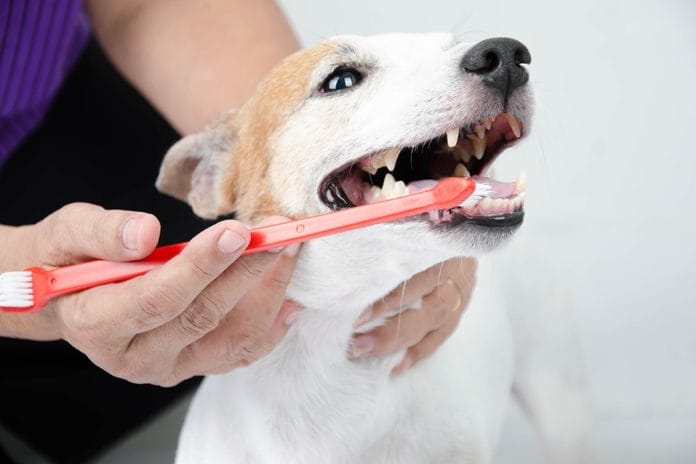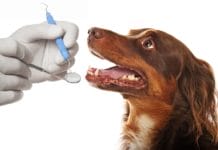Pet oral health has become a huge topic lately with so many hygienists being animal lovers, as well as oral health experts. We know that each state has different requirements allowing hygienists to complete professional pet prophylaxis, and it all seems quite obscure as to what the exact requirements are. Attending a recent veterinary conference in San Diego, California, I asked for clarification but was unable to get any hard and fast answers. What I did discover though was quite informative in other ways.
Many of our dental distributors also represent veterinary medicine. The Schein display was quite impressive and frankly looked like the dental display minus the operatory chair, decked out with a large cabinet and countertop in its place. Schein represents veterinarians in the same manner as it does dentists, including all supplies, as well as dental hygiene instruments and products. The supply of prophy paste, fluoride, and prophy angles was impressive, along with the ultrasonic units and instruments.
It was surprising to see that many of the hygiene instruments were the same, the H6/H7 is ever popular as well as the Gracey series. Browsing through the displays of several instrument manufacturers showed, while the tips may be the same, that is where the similarities end. The price per instrument is significantly lower. When handling the instrument, it was apparent the metal, and the handle design is quite different. The handles come in a variety of shapes, but most were very thin and had the older crosshatch design from the early ’80s. The actual material used was less dense and not designed to hold an edge in the same highly technological way human dentistry provides. Each scaler was priced at a cool $13, and 2 for $22, with a discount offered for larger purchases. There was no talk of sharpening, and no sharpening products were seen in the displays.
The loupe display was also surprising; I had never seen so many different frame options, including Ray Ban. The magnification was variable, in anything from a 2.0 to 5.5, in both flip-up and through the lens options. Yet, many seemed quite a bit less clear, with less crisp edges than my own loupes. The lights were few and far between, with fewer options offered, though the cost was significantly lower. Speaking with the representatives made it clear that most in the pet dental arena do not currently practice with magnification, and loupes are just now becoming more of a trend.
Interesting was the sheer volume of distributors offering CBD/hemp-based products for our fur babies. These medications were being offered to help with movement, calming aching joints, (I found that statement hilarious), as well as to decrease itching, and decrease stress in anxiety-prone pets. It appears these well-regulated additives are going to become very popular and are the new “it” line in veterinary trends, as they are becoming with humans.
Now for the most interesting discovery for hygienists, the veterinary oral health prescription diets and supplements. Royal Canin offered reams of research on their dental diet for both dog and cats. For instance, “Brushing Effect: The texture and shape of the kibble produce a gentle abrasive effect on the teeth during chewing. This mechanical action provides a brushing effect to reduce the accumulation of dental plaque and calculus. Plaque and Tartar Control: Sodium tripolyphosphate (STPP) binds salivary calcium, making it unavailable for the formation of calculus, and a specific nutrient incorporated by Royal Canin helps reduce dental plaque build-up.”
The representative explained that it is the combination of the mechanical action of scraping the tooth along with the additive of the STPP to reduce the bacterial colonization forming the calculus that creates a cleaner dental environment, reducing gingivitis and periodontal disease in our pets. These prescription foods were not used in place of professional cleanings, but in addition to prophylaxis, creating a healthier oral environment. Interestingly, the benefit was also found in the gut and urinary tract. Overall, it was nice to see they were able to produce such a large amount of science-based research and offered to share the studies and data in a way I found quite refreshing and compelling.
Maxi/Guard by Addison Biological Laboratory is an entire product line dedicated to pet oral health; it is a hygienist’s dream. They offer excellent visuals demonstrating healthy mouths, gingivitis, and periodontal disease in a variety of pets, including exotics. This pamphlet will definitely be in my operatory as an adjunct to hygiene instructions. The product line has an oral cleansing gel, as well as an oral wipe. The wipe is simple to use and can replace brushing of pets’ teeth with a simple swipe. The wipe is textured to remove plaque and food debris, as well as impregnated with a “unique zinc formulation.” These wipes are simple to use by folding over a finger and gently wiping over the teeth and gums. Trying them on my own pet shows they are indeed simple to use and easily tolerated by the fussiest of pups.
There is also a powder additive to food by VetriScience which offers periodontal support claiming to “penetrate plaque and support gum health.” The product claims to reduce plaque by 20% and tartar by 18% but the study size is limited, and further testing continues. The taste seems to be easily tolerated, and it does contain probiotics, so possibly good for gut health as well.
Overall, it is interesting to see how our very own dental and hygiene conferences translate to the veterinary world, with a conference offering many continuing education opportunities, and a huge space exclusive to vendors touting new and traditional product lines. As a dental hygienist, I was pleased to see how receptive all of the veterinary oral health distributors were, and how graciously samples and research were offered.
Each of these vendors was easily able to compare and contrast products between multiple species and compare the research and science to our human patients. For those hygienists looking for non-traditional work opportunities, veterinary dental product lines also need representatives, and this might be a wonderful change of careers for the pet lovers out there!
SEE ALSO: Veterinary Dental Hygiene: Every Hygienist’s Dream Prophylaxis














